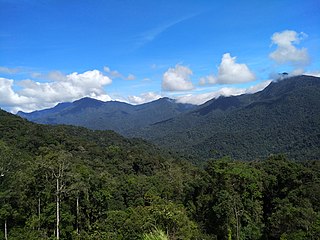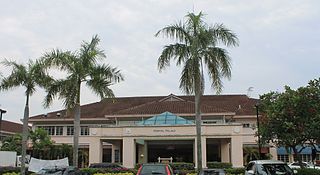
The Malacca Sultanate was a Malay sultanate based in the modern-day state of Malacca, Malaysia. Conventional historical thesis marks c. 1400 as the founding year of the sultanate by King of Singapura, Parameswara, also known as Iskandar Shah, although earlier dates for its founding have been proposed. At the height of the sultanate's power in the 15th century, its capital grew into one of the most important transshipment ports of its time, with territory covering much of the Malay Peninsula, the Riau Islands and a significant portion of the northern coast of Sumatra in present-day Indonesia.

Negeri Sembilan, historically spelled as Negri Sembilan, is a state in Malaysia which lies on the western coast of Peninsular Malaysia. It borders Selangor on the north, Pahang in the east, and Malacca and Johor to the south.

The Titiwangsa Mountains, also known as Banjaran Besar by locals, is the chain of mountains that forms the backbone of the Malay Peninsula. The northern section of the range is in southern Thailand, where it is known as Sankalakhiri Range.

The Johor Sultanate was founded by Sultan of Malacca Mahmud Shah's son, Alauddin Riayat Shah II in 1528.

The Pahang River is a river that mainly flows through the state of Pahang, Malaysia. Its drainage basin covers its namesake state as well as the neighbouring state of Negeri Sembilan.

Bahau is the principal town of Jempol District, Negeri Sembilan, Malaysia.

The Jempol District is the largest district in the Malaysian state of Negeri Sembilan. The district borders Jelebu District to the northwest, Kuala Pilah District to the west, Tampin District to the south, Bera District, Pahang to the northeast and Segamat District, Johor to the east. Bandar Seri Jempol and Bahau are the principal towns in Jempol.

The Muar River is a river which flows through the states of Negeri Sembilan and Johor in Malaysia. Its drainage basin encompasses the states aforementioned, as well as Pahang and Malacca.

The Malacca River is a river in Malaysia which flows through the middle of the state of Malacca. It was a vital trade route during the heyday of Malacca Sultanate in the 15th century.

Malacca General Hospital is a government-funded public hospital in Malacca City, Malacca, Malaysia. A secondary and specialist hospital, it serves as a referral centre for patients from primary and health centres in the state as well as the northern part of Johor and the Tampin district of Negeri Sembilan.

Serting is a hamlet in Jempol District, Negeri Sembilan, Malaysia. There are many tourist attractions including Gunung Datuk in Serting Hilir. According to 2021 census, Serting has a population of 5588. The male population is 2858 while the number of females are 2730. The total area of Serting is 2.066 square km. Tourists who want to view Straits of Melaka take a hike to the peak of Gunung Datuk to get a good 360-degree view.

The Linggi River is a river in Malaysia which flows through the states of Negeri Sembilan and Malacca. It is one of two major rivers that serve as water sources for most of Negeri Sembilan's population, the other being the Muar River, which constitutes the state's eastern half.

Malacca, officially the Historic State of Malacca, is a state in Malaysia located in the southern region of the Malay Peninsula, facing the Strait of Malacca. The state is bordered by Negeri Sembilan to the north and west and Johor to the south. The exclave of Tanjung Tuan also borders Negeri Sembilan to the north. Its capital is Malacca City, which has been listed as a UNESCO World Heritage Site since 7 July 2008.
Sultan Abdul Jamil Shah I ibni Almarhum Sultan Muhammad Shah was the third Sultan of Pahang who reigned from 1495 to 1512. He was installed by Sultan Mahmud of Melaka in 1495 following the abdication of his uncle, Ahmad Shah I. Earlier, his cousin and son of Ahmad Shah, Mansur Shah succeeded his father at young age. Abdul Jamil took the responsibility as a regent and exercised greater authority in the government. He reigned jointly with Mansur Shah until his death in 1512.
Sultan Zainal Abidin Shah ibni Almarhum Sultan Mahmud Shah was the seventh Sultan of Pahang who reigned from 1540 to 1555. He succeeded on the death of his elder brother in 1540.

Old Pahang Kingdom was a historical Malay polity centred in the Pahang region on the east coast of the Malay Peninsula. The polity appeared in foreign records from as early as the 5th century and at its height, covered much of modern state of Pahang and the entire southern part of the peninsula. Throughout its pre-Melakan history, Pahang was established as a mueang or naksat of some major regional Malayic mandalas including Langkasuka, Srivijaya and Ligor. Around the middle of the 15th century, it was brought into the orbit of Melaka Sultanate and subsequently established as a vassal Muslim Sultanate in 1470, following the coronation of the grandson of the former Maharaja as the first Sultan of Pahang.

Piala Tun Sharifah Rodziah is a women's football tournament in Malaysia. It was established in 1976 as a women's football competition competed by the teams around Malaysia. The competition is managed by the Football Association of Malaysia (FAM).

The Pahang Sultanate also referred as the Old Pahang Sultanate, as opposed to the modern Pahang Sultanate, was a Malay Muslim state established in the eastern Malay Peninsula in the 15th century. At the height of its influence, the sultanate was an important power in Southeast Asia and controlled the entire Pahang basin, bordering the Pattani Sultanate to the north and the Johor Sultanate to the south. To the west, its jurisdiction extended over parts of modern-day Selangor and Negeri Sembilan.

Segamat is a town and district capital located in Segamat District, Johor, Malaysia.

The Minangkabau Malaysians are citizens of the Malaysia whose ancestral roots are from Minangkabau of central Sumatra. This includes people born in the Malaysia who are of Minangkabau origin as well as Minangkabau who have migrated to Malaysia. Today, Minangkabau comprise about 989,000 people in Malaysia, and Malaysian law considers most of them to be Malays. They are majority in urban areas, which has traditionally had the highest education and a strong entrepreneurial spirit. The history of the Minangkabau migration to Malay peninsula has been recorded to have lasted a very long time. When the means of transportation were still using the ships by down the rivers and crossing the strait, many Minang people migrated to various regions such as Negeri Sembilan, Malacca, Penang, Kedah, Perak, and Pahang. Some scholars noted that the arrival of the Minangkabau to the Malay Peninsula occurred in the 12th century. This ethnic group moved in to peninsula at the height of the Sultanate of Malacca, and maintains the Adat Perpatih of matrilineal kinships system in Negeri Sembilan and north Malacca.























